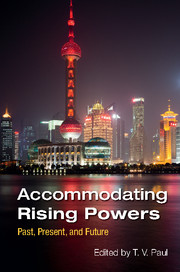Book contents
- Frontmatter
- Contents
- List of figures
- List of contributors
- Acknowledgments
- Part I Mechanisms of accommodation
- Part II Historical cases
- 6 Seizing the day or passing the baton? Power, illusion, and the British Empire
- 7 The US accommodation of Communist China
- 8 Accommodation and containment: Great Britain and Germany prior to the two world wars
- 9 Did the United States and the Allies fail to accommodate Japan in the 1920s and the 1930s?
- Part III Contemporary cases
- Part IV Conclusions
- Index
9 - Did the United States and the Allies fail to accommodate Japan in the 1920s and the 1930s?
from Part II - Historical cases
Published online by Cambridge University Press: 05 March 2016
- Frontmatter
- Contents
- List of figures
- List of contributors
- Acknowledgments
- Part I Mechanisms of accommodation
- Part II Historical cases
- 6 Seizing the day or passing the baton? Power, illusion, and the British Empire
- 7 The US accommodation of Communist China
- 8 Accommodation and containment: Great Britain and Germany prior to the two world wars
- 9 Did the United States and the Allies fail to accommodate Japan in the 1920s and the 1930s?
- Part III Contemporary cases
- Part IV Conclusions
- Index
Summary
At first glance, the steady deterioration of relations between the United States and Japan in the late 1930s, culminating in the Japanese Combined Fleet's attack on the US Pacific Fleet at Pearl Harbor, Hawaii, on December 7, 1941 and the US entry into World War II (WWII), would appear to be the textbook case of failure by an established great power (the United States) to either peacefully accommodate or successfully deter a rising challenger (Japan). The United States viewed Japan's search for autarkic economic development through territorial expansion in China and, later, South East Asia as predatory and dangerous.
Instead of acquiescing to Tokyo's territorial ambitions in East Asia or finding a way to peacefully integrate Japan into a Western-led international system, the administration of President Franklin D. Roosevelt resorted to coercive diplomacy after the outbreak of the second Sino-Japanese War in July 1937. The United States lacked the military forces and the domestic support necessary to stop the Japanese military advance in China, but nevertheless had ample coercive leverage. By 1939, Japan depended on the United States for 80 percent of its fuel products, more than 90 percent of its gasoline, more than 60 percent of its machine tools, and about 75 percent of its scrap iron. As the United States, joined by the United Kingdom and the Netherlands, tightened the economic screws in 1940 and 1941, Japanese leaders pursued further conquests in South East Asia, eventually seizing the French and Dutch colonies in Indochina and the East Indies and threatening the British colonies in Singapore, Hong Kong, and Malaysia, as well as the Philippines (then a US commonwealth). After the Roosevelt administration deployed the US Pacific Fleet to Hawaii and imposed a de facto oil embargo in late July 1941, ostensibly as a deterrent, Japanese leaders adopted a two-track strategy: enter into high-level negotiations with Washington for a resumption of bilateral trade and recognition of Japanese territorial acquisitions since 1937, but also secretly prepare for war with the United States.
Roosevelt told a joint session of Congress the day after the Pearl Harbor attack: “The United States of America was suddenly and deliberately attacked by naval and air forces of the Empire of Japan.
- Type
- Chapter
- Information
- Accommodating Rising PowersPast, Present, and Future, pp. 173 - 198Publisher: Cambridge University PressPrint publication year: 2016
- 2
- Cited by



